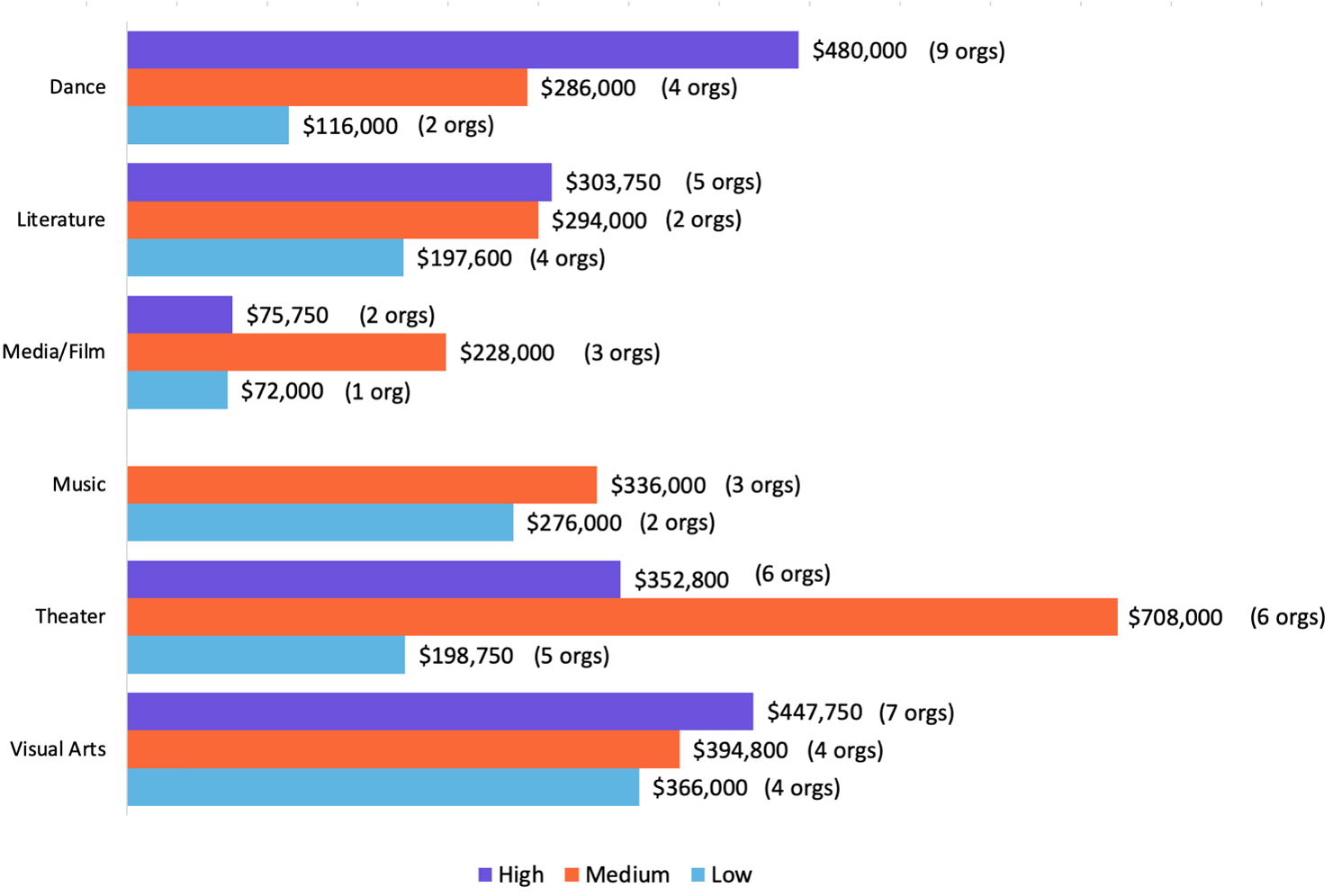FY22
Annual
Review
May 1, 2021–April 30, 2022
Images clockwise, from upper left: (1) Pillsbury House Theatre, Naked Stages: image from C. Michael Menge’s giving the people what they want. (2) Carson Faust, 2021 Jerome Hill Artist Fellow. (3) Movement Research: zavé martohardjono, TERRITORY: The Island Remembers, 2022. Photo by Kathleen Kelley. Collage by zavé martohardjono. (4) The Laundromat Project: still from a “nourishment video” (part of Afropeach) by collaborators Rochelle Jamia Wilbun and Ogemdi Ude.
FY22 Overview
Founded by artist Jerome Hill in 1964, the Jerome Foundation supports artists in Minnesota and New York City at early points in their vocational careers and organizations who nurture, produce and/or present such artists.
When the Foundation published its last year in review in June 2021, the arts community was just beginning to emerge from the COVID pandemic. For more than a year, performing arts venues had been shuttered, visual arts exhibitions cancelled, and film distribution limited almost exclusively to streaming. Staffs had been furloughed or downsized, commissions suspended, and once bustling performing arts districts hollowed out with the collapse of restaurants and coffee bars, abandonment of office space, and new preferences for home-based workplaces.
There had been, however, hopeful signs: artists and organizations had been creative, streaming performances, Zoom events and on-line classes, organizing pop-up outdoor distanced events, and offering venues to serve community needs beyond performances. Many had embarked on deep and sometimes painful discussions about the roles they were playing in their communities, their audience and staff composition, their roles in dismantling racial inequity and injustice, and their larger purpose beyond their missions.
Thanks to emergency funding efforts of foundations, government and donors, the majority of arts organizations were finding themselves in stronger financial positions than they had been in before the onset of the virus. The COVID Delta variant was beginning to subside, and a return to the workplace seemed imminent in a matter of months if not weeks. Indeed, the FY21 report proclaimed, “Today is a moment (barring the outbreak of a new variant virus) of a thaw…”
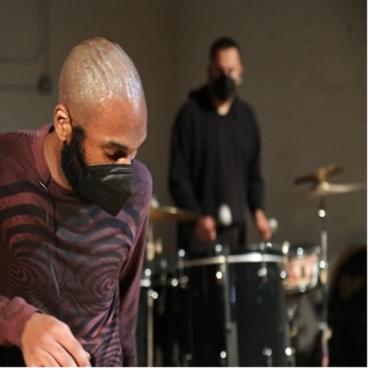
The Chocolate Factory Theater: Justin Allen, Frequency.
That caveat unfortunately proved haunting as the hopes of a quick return were dashed by the appearance of the Omicron variant. As organizations were forced to retreat yet again and artists again faced diminished opportunities, the Jerome Foundation expanded its commitment to the arts. The Foundation extended and increased grant amounts for organizations by 20%, awarded new grants (including additional grants for finalists and alternates) in the Film, Video and Digital Production programs, launched an Artist Development Program for MN film artists, embarked on funding a new class of Jerome Hill Artist Fellows and broadened the number of supported disciplines for the upcoming FY23 fellowships. The Board took its first steps towards ESG (Environmental, Social and Governance) investing and continued critical equity, diversity and inclusion work with Dr. Dwinita Mosby Tyler and Ariana Flores of The Equity Project. And in an effort to stay deeply connected with the arts community in both of its priority geographic areas, the Foundation added its first ever staff member based in New York City.
Throughout this journey, the Members, Directors and Staff[1] were constantly inspired by the resilience and passion of artists and the entire arts community. A growing sense that the arts are more essential than ever—both spiritually and socially—was especially palpable as the field embarked on major reforms and shifts in direction. Through its dedication to multi-year, flexible grants, the Foundation sought to offer grantees the latitude to embark on such new directions with the certainty of support.
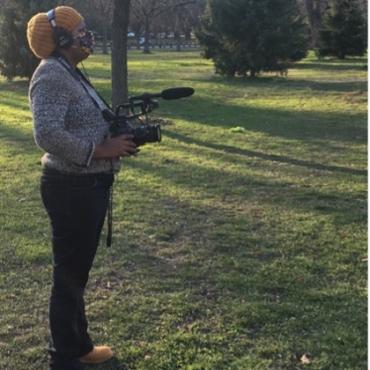
Bronx Documentary Center Fellow Aryana Alexis Anderson.
COMMITMENT TO EQUITY, DIVERSITY AND INCLUSION
Since declaring diversity in race, gender, sexual orientation, aesthetics, discipline, generation, physical ability and points of view as a core value in 2016, the Foundation has deepened this commitment to embrace inclusion and equity. The Foundation believes the quest for equity is essential for our society and that in this quest the arts have a unique and important role to play.
Since 2016, Jerome Programs have been grounded in community input through convenings, focus groups and open surveys. While Staff is responsible for translating this input into programs and initiatives, applications are reviewed and grantees recommended to the Board for final approval by community panels of artists and arts professionals. Rather than serving as critics or adjudicators, Staff primarily now see their roles as learners, conveners, synthesizers and facilitators.
Many of the hallmarks of Jerome programs—the decision to launch programs through an open call rather than by invitation, the increase in average grant awards, the greater flexibility in use of funds, the pairing of individualized professional development opportunities with Fellowships, the greater emphasis on trust-based grantmaking, the alignment of grantees with Foundation values and the decision to spend beyond the traditional 5% level for a five- year period reflect a drive towards greater social equity.
In FY22, 69 out of 86 (80%) grantee arts organizations had a racial equity focus. See Part III for more racial equity assessments and information on how the Jerome Foundation evaluates racial equity in arts organizations.
Detailed specific demographics for panelists, grantee artists, grantee organizational and project leaders and the Jerome Members, Board and Staff also follow in Part II.
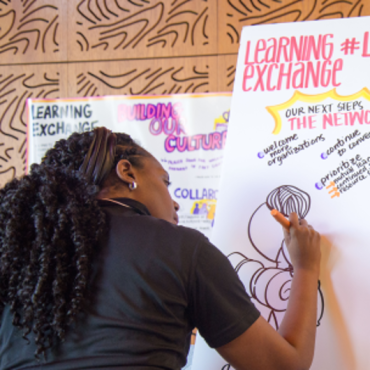
Photo courtesy the Mosaic Fund of the New York Community Trust.

GRANT GIVING IN FY22
In FY22, the Foundation paid a total of $4,964,548 in grants—
$1,027,622 more than its formula-mandated grants giving level.
[2]

GRANTS FOR ARTISTS
Total grants paid to artists: $2,323,498
Total outstanding commitments: $1,641,152
Jerome Hill Artist Fellowship Program
In FY22, the Foundation made first payments totaling $1.5M of a $3M commitment for 60 Fellowships awarded in the second round of the Jerome Hill Artist Fellowship program. These grants support artists in dance, film/ video/ new media, literature, music, theater/ performance/ spoken word and visual arts at early stages in their careers, enabling them to pursue self-defined activities to create new work, enhance their long-term artistic development and/or strengthen their career prospects long term.
Fellowships are annually valued at $25,000 for two successive years ($50,000 total). In addition to their grant awards, all interested Fellows also receive free individualized professional development counseling provided by the MAP Fund of New York’s Scaffolding for Practicing Artists (SPA) program.
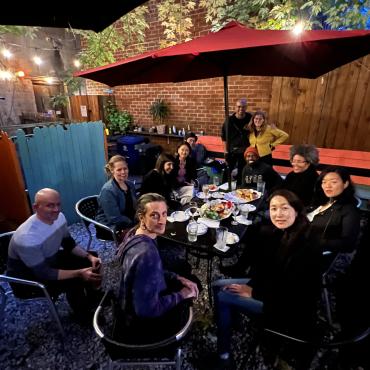
2019 Jerome Hill Artist Fellows and MAP Fund staff at a Scaffolding for Practicing Artists gathering in NYC.
Minnesota and New York City Film, Video and Digital Production Grants
The Minnesota and New York City Film/ Video/ Digital Production programs are the Foundation’s longest-standing initiatives, awarding grants of up to $30,000 to directors to support specific film/video/digital production projects in animation, documentary, experimental and narrative genres.
In FY21, focus groups had been convened to understand a steady decline in Minnesota applications, which had fallen 40% since 2016, even while NY applications had continued to increase. These groups and subsequent survey respondents accordingly recommended recommended easing eligibility requirements, reducing the number of required work samples and adding small pre-production artistic development grants for MN artists. These recommendations were implemented for the first time in FY22. Total applications in MN increased 61% over the prior round, with 72% requesting full production support and 28% requesting pre-production support.
In FY22, the Foundation awarded a total of 24 grants totaling $538,000 through the MN and NYC programs. The Foundation additionally awarded 14 smaller grants to panel-identified alternates and finalists totaling $65,000.
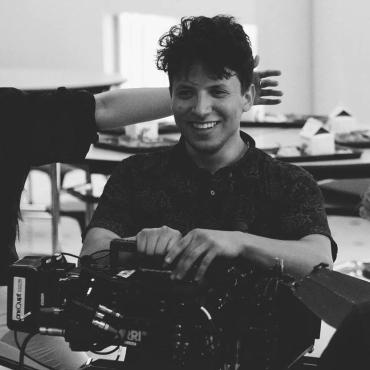
Minnesota production grantee Tahiel Jimenez Medina. Photo by Tinker Yan.
Jerome@Camargo
Administered by the Jerome Foundation, the Jerome@Camargo program supports artist residencies at the Camargo Foundation in Cassis, France. Grants of $6,000 for four-weeks or $9,000 for six-weeks support honoraria, travel expenses, artist materials, per diems and housing. Unlike other programs, applications are by invitation only and are limited to artists previously supported through other Jerome programs.
In FY22, the COVID pandemic disrupted Camargo’s programs, including but not limited to Jerome@Camargo. As a result, applications were suspended for most of the year, and payments reflected commitments for residencies that had been approved in earlier years but delayed with the onset of COVID.
The Board of Directors did, however, approve an additional allocation of $150,000 to support two additional rounds of the program and reopened applications in the spring of 2022. Specific grantees were subsequently approved by the Jerome Board in June 2022 and will be identified in the FY23 report.
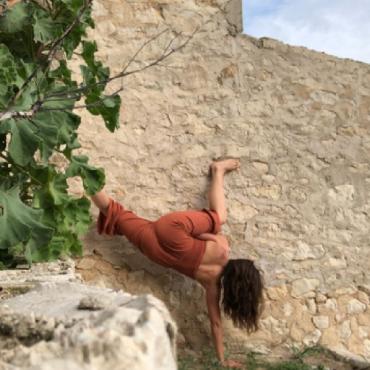
Jerome@Camargo resident Leila Awadallah’s Bone structure, stone structure; photo by the artist.

GRANTS FOR ORGANIZATIONS
Total grants paid to organizations: $2,716,050
Commitments for additional future payments: $4,390,200
[4]
Support for Arts Organizations Initiative
In January 2020, the Foundation had awarded two-year project grants to 62 organizations. With the advent of COVID in March 2020, the Foundation quickly restructured this support to give grantees greater flexibility in moving forward, awarded additional finalist and alternate grants in all programs, and joined several large consortium efforts to support artists and arts organizations.
In the Foundation’s customary schedule, a new call for applications would have begun in late 2020, with applications due in May 2021, panels in the fall and grants awarded in January 2022. But with the extension of the COVID crisis, the Foundation realized that requesting such applications would be both burdensome and unrealistic: with still no end of the crisis in sight, organizations would have been unable to predict when they would return, who would be leading activities, on what scale such activities would operate and how they would be structured.
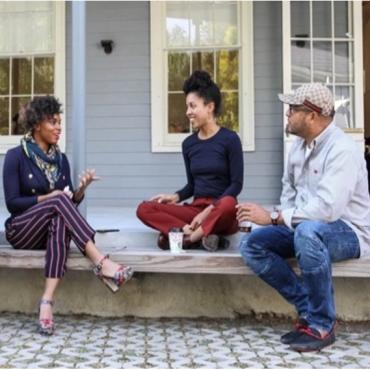
Firelight Media Documentary Lab participants.
As a result, the Foundation elected instead to extend these grants for an additional two years with a 20% increase in grant size, affording these organizations valuable time not only to return but to restructure and adapt their work with early career artists in line with their new goals around their mission, values and commitment to equity. These extensions represented a total commitment of $5,466,000 to be paid primarily in FY23 and FY24.
MN Dance Initiative
Even as the grants cited above were made, the Foundation was conscious of its historic under-funding of Minnesota dance organizations. Using the same process of focus groups and surveys that had been used in reimagining the MN Film, Video and Digital Production Program, the Foundation convened multiple groups in FY22 to assess the needs of the MN dance community. Based on their conversations and subsequent survey input, the Board approved a limited RFP for dance and presenting organizations in Minnesota. Specific grants in this initiative totaling $530,136 were subsequently determined in June 2022 and will be reported as part of the FY23 report.
First Peoples Fund
Even as it has broadened its roster of grantees, the Foundation has consistently recognized its own lack of deep reach into the community of Native American artists, many of whom had found the Foundation programs problematic, predicated on perceptions of culture and career phase that did not recognize their own beliefs and out of alignment with their needs. As a step in reaching more deeply into the community of Native American artists, the Foundation awarded a two-year $120,000 grant specifically to support programs, services and activities for early career Native American artists through First Peoples Fund.
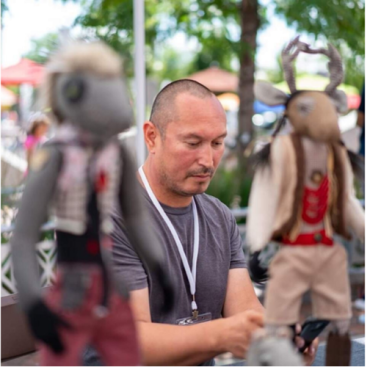
First Peoples Fund: Gene Swallow (Oglala Sioux), 2021 Photo provided by the artist.
Consortium Grants
In addition to its own direct grants, the Foundation awarded $1,000,000 in FY21 to two consortium efforts designed to address specific needs faced by BIPOC artists and organizations through the Seeding Cultural Treasures initiative in Minnesota and the Mosaic Project in New York City. The second and final installment of these grants was paid in FY22.
Arts Convenings and Research
As part of its ongoing programs, the Foundation makes a limited number of grants for national convenings that are held in Minnesota or New York City and that include early career artists. In FY22, the Foundation supported two such convenings totaling $14,000.
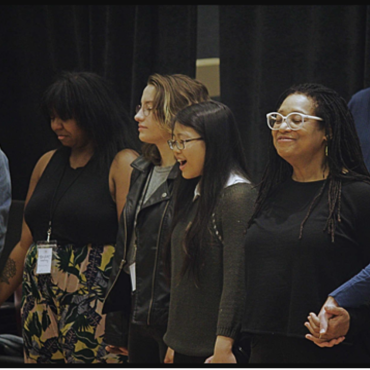
Participants at the New Music Gathering.
Pilot Leadership Transition Grants
In FY22, the Foundation continued to explore a pilot initiative supporting career transitions at arts organizations, awarding grants both for costs associated with a search for a new leader, and discretionary fund for the new leader once. These by-invitation grants are generally limited to $10,000 for searches and $10,000 for discretionary funds and are available only to organizations with which the Foundation has a significant prior funding history. Two organizations received such grant support in FY22 for a total of $40,000.
GOVERNANCE & STAFF
The Jerome Foundation Board of Directors is composed of nine Directors, each eligible to serve for up to nine years. Directors generally are chosen based on their commitment to and experience in the arts, their affinity with Foundation values, and their abilities to rise to the higher challenges of governance beyond traditional oversight. The deliberately diverse Board includes representatives of both the Minnesota and New York City arts communities, spanning multiple races, disciplines, generations and points of view.
The Members of the Jerome Corporation are 3-5 individuals who serve a maximum of 15 years, are connected to the Hill family either by interest or by heritage, and are charged both with preserving the legacy of founder Jerome Hill and with electing the Board of Directors.
The Staff includes a program staff, an administrative staff, a finance office and a President, who are collectively charged with day-to-day operations and executing the strategy and directives adopted by the Board.
Additional biographic information about each Director and Staff can also be found on this website.
In FY22, the Foundation was led by a Board of Directors and Members of the Corporation as listed below:
BOARD OF DIRECTORS
Chair: Kate Barr, Executive Director of Propel Nonprofits (Minneapolis, MN)
Vice Chair: Linda Earle, Professor of Practice in Art History at the Tyler School of Art- Temple University (New York, NY)
Secretary: Daniel Alexander Jones, Performer/writer (Los Angeles, CA)
Treasurer: Rick Scott, Retired McKnight Foundation Vice-President of Finance (St. Paul, MN)
Sarah Bellamy: President of Penumbra (St. Paul, MN)
Helga Davis: Vocalist and Performance Artist (New York, NY)
Thomas Lax: Curator of Media and Performance, Museum of Modern Art/ MOMA (New York, NY)
Lori Pourier: President/CEO First People’s Fund (Rapid City, SD)
Sanjit Sethi: President, Minneapolis College of Art and Design (Minneapolis, MN)
Elizabeth Streb*: Founder and Artistic Director, Streb (New York, NY)
MEMBERS OF THE JEROME CORPORATION
Chair: Sara Maud Lydiatt-Vanier (Montreal, CA)
Elizabeth Hlavka (Minneapolis, MN)
William Sheeline (Oyster Bay, NY)
Nicholas Slade (St. Paul, MN)
Emeritus: Mari Harpur (St. Paul, MN), Sheila ffolliott (Washington, DC), William Russell (Hanahan, SC)
STAFF
The Jerome Foundation staff was composed of a core staff working in Minnesota, a financial accountant and controller engaged through CliftonLarsonAllen, and one Program Associate based in New York City, as follows:
Lann Briel, Program Officer (left Foundation May 2021)
Andrea Brown, Grants and Program Administrator
Ben Cameron, President
Coretta Kendricks, Accountant
Lori Lawonn, Controller
Melissa Levin (Associate Program Officer, New York City)
Lara Mimosa Montes (Associate Program Officer)
Eleanor Savage (Program Director)
* Elizabeth Streb’s nine-year tenure as a Director ended in June 2021, with Helga Davis being elected by the Members at their Annual Meeting as her successor.
ADMINISTRATIVE EXPENSES & ASSETS
Administrative expenses totaled $1,084,942 of the charitable budget for the fiscal year, inclusive not only of all rent, salaries, consultant fees, technology etc., but also of all panel and board meeting expenses, panel honoraria and memberships in philanthropic organizations.
These administrative expenses do not include additional non-operating costs of excise taxes, investment fees and timber management, which totaled an additional $352,302. None of these non-operating costs are considered charitable expenses, and all are paid in addition to the 5% distribution.
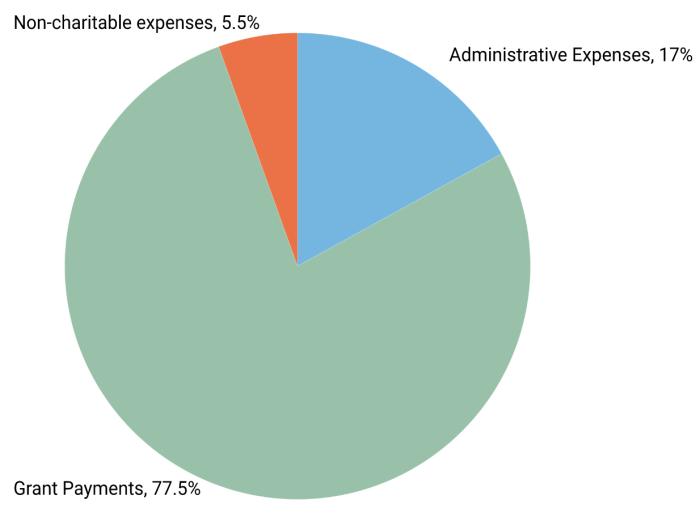
Total Jerome assets composed of financial investments and a limited timber holding in Oregon decreased in value 10.8% from $127,844,658 on May 1, 2021 to $114,000,996 on April 30, 2022, primarily due to weakened performance in financial markets. In addition, the Foundation had withdrawn and distributed a total of $6,443,245 in charitable and non-charitable payments during the fiscal year.
LOOKING AHEAD
As this report is being written in early summer 2022, many organizations have only recently undertaken the steps they had hoped to take a year earlier. Postponed commissions are being revived, new employment opportunities are opening, and organizations are scaling up with new and often expanded staffing. In the wake of extraordinary COVID-relief giving from donors, foundations and especially the federal government, many arts organizations now report that they are actually in healthier financial shape than they were before the pandemic began. Audiences are cautiously and slowly beginning to return, even as new COVID variants are appearing.
Looking forward, new questions are likely to confront the arts, including the following:
- With the disappearance of special COVID relief funding, how much longer can this stronger financial health continue?
- How will the decimation of cultural district restaurants, coffee shops and traditional business workspaces affect audience return?
- How will the arts lure the significant percentage of past patrons who are reluctant to return as well as new patrons?
- Might a growing hunger for social experiences and a deeper relevance of arts as a voice for social change attract a public that has never perceived an interest in the arts before?
- With more recent economic volatility and soaring inflation, what will be the impact on consumer discretionary income and on arts organizations’ own investments (for those lucky enough to have them)?
- Will the “great resignation/ exit” continue—a phenomenon that has seen the defection of many from the field and an unprecedented level of turnover?
- Where will the field find its new leaders?
- Is the dramatic increase in foundation and government funding for BIPOC organizations the beginning of a sustained new chapter that will begin to redress the historic inequities of funding or will it be—like many other funder priorities of the past—a momentary phenomenon?
- And how will the arts move beyond representation and programming to larger strategies of promoting greater cultural and racial equity in its organizations and communities?
Even with the uncertainty of the future and the disorienting impact of significant change, this is a moment not only of recovering but of a major turning, enormous possibility and possible reconfiguration of the sector itself. Many arts groups are shifting from the traditional goal of stability to a new focus on resilience and adaptability. They recognize that the COVID phenomenon is less likely to be an isolated event than the first of many ongoing disruptions—whether stemming from new diseases, climate upheaval, social unrest, terrorism (either domestic or international) or a host of other potential causes—and agree that organizations who have prioritized adaptability and resilience are those most likely to survive.
And there is a palpable sense that the survival of the arts is increasingly important for a nation that is deeply divided and torn by pandemics of a different sort—pandemics of disinformation, polarization, and mutual political contempt. In a time in which violence is increasingly embraced as an appropriate response to difference, book banning and limits on free expression are on the rise, and people find it increasingly difficult to share the same physical space with those with whom they disagree, the arts promote deep listening, social interaction, forums in which people of different beliefs and races and histories can come together to share a common experience. Especially as the country must find new ways of bonding across racial, political, religious and generational lines, the arts have a critical role to play in forging new pathways to remembering, understanding and forgiveness.
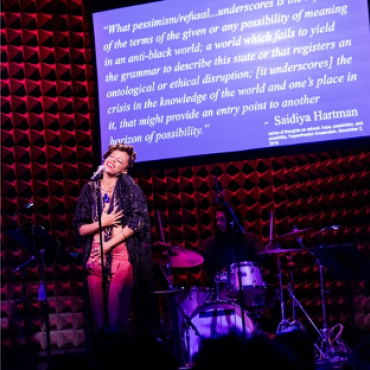
Musical Theatre Factory: MTFxR Maker Nia Witherspoon.
With the planned retirement of the Foundation President in 2023, Jerome will soon embrace a new President who will bring insights, perspectives and commitments of their own, even as they face new potential financial constraints in this uncertain national economy. That said, the Board—which continues to be constituted of arts professionals—has committed to enlisting a leader that will be thoughtful, intentional and fearless in partnership with the arts community as the Foundation moves forward. The Foundation continues to look forward to that partnership and to support artists and arts organizations in the future as they move forward.
[1] Members, Directors and Staff are all part of the Jerome Foundation structure but each play different roles. A fuller description of the role of each can be found in the Governance and Staff section later in this report.
[2] While the IRS requires private Foundations to distribute a minimum of 5% of its assets each year, Jerome and many other foundations use a 36-month average of assets to determine their annual distribution. In FY20 the Jerome Foundation committed to overspending this formula by a minimum of $8M in grants over 5 years to help artists and organizations address the stress occasioned by COVID and embrace social change. Recognizing that emergency COVID relief efforts were likely to end long before the arts community had recovered and that a new President, slated to arrive in 2023, might have new priorities that would warrant immediate support, the Foundation has deliberately elected to reserve the majority of this overspending for allocation and distribution in 2023-2025.
[3] 2020 Arts Organization Grants Program, 2021 Jerome Hill Artist Fellowship, 2021 Film, Video and Digital Production (MN & NYC) & Artist Development (MN)
[4] These commitments include specific grants that will be paid in future years but does not include include the uncommitted balance of the special additional $8M spending or the MN Dance initiative, whose grantees were determined in FY23.
PART II: Grantee, Panelist, Staff and Board Demographics
PART III: Grantee Arts Organizations Racial Equity Evaluation
Note: the following data regarding organizations is based on the Racial Equity in Grantmaking (REG) coding process.* Racial Equity is defined as centering peoples of Black, Native American and Indigenous, Asian, Latinx and/or Middle Eastern/North African descent or POC for the purpose of abbreviation.
Measuring internal and external organizational achievement in racial equity can be complex and difficult. One possible approach is a coding process, based on responses to questions from organizations and developed by a small cohort of grantmakers convened by Program Director Maurine Knighton from Doris Duke Charitable Foundation and Eddie Torres from Grantmakers in the Arts, to test a system for measuring racial equity in arts grantmaking. More information about the cohort is available at https://www.giarts.org/blog/eddie/racial-equity-coding-project
Jerome staff, in addition to working with our previous data sets, asked Arts Organization grantees and alternate and finalist grantees receiving 2022-24 Renewal Funding to respond to questions in the renewal form focused on racial equity assessment and used this new system to assess the organization grantees across all of Jerome’s grantmaking for FY22.
The first measure of this coding process was to assign a “Yes” or “No” to each organization. A code of “Yes” was assigned to organizations that involve some degree of racial equity, in the organization’s leadership, staff and board and/or artists served in the program. A code of “Yes” indicates that these grants will receive further assessment around their racial equity focus. A code of “No” was assigned to organizations that don’t address racial equity.
How many grants had a racial equity focus? 69 out of 86.
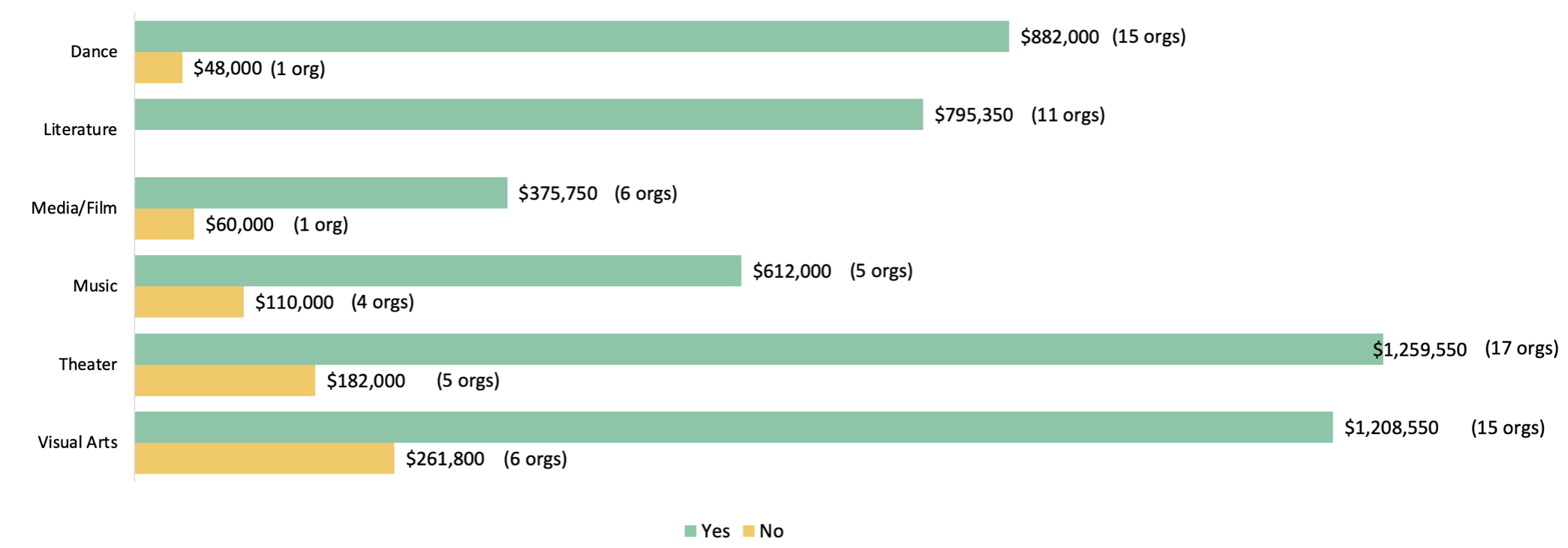
Those organizations receiving a “Yes,” are then assessed based on the degree of racial equity in terms of by, for and about peoples of Black, Native American and Indigenous, Asian, Latinx and/or Middle Eastern/North African descent (POC).
an assessment of the organization—the involvement of POC in organization’s leadership (board and staff), mission and focus and impact of programming
an assessment of the grant program/project—evaluating the percentage of the grant’s beneficiaries that are of POC, along with the organization’s demonstrated commitment to these beneficiaries over time, and program/project intentions reflective of the organization’s mission and vision
an assessment of the grant program/project—evaluating the percentage of POC program or project leadership and POC program content (including racial equity intentions in the structure of the program activities and goals or purpose)
BY:
Organization’s leadership (board and staff) includes POC; the mission and focus and impact of programming center POC
- High = Organization’s reason for being is related and is likely articulated in its mission statement. It exhibits deep commitment over time to POC peoples and activities.
- Medium = Organization shows evidence of ongoing commitment to equitable practices, over years, beyond language alone, and major progress in at least two of the following: significant presence of POC in senior leadership, board and staff; consistent, substantive programming centering POC; substantial focus and impact on communities of color.
- Low = Some evidence of commitment to POC, such as meeting only one of the above measures, or having done EDI trainings, but at a beginning stage in the work or progress is uncertain.
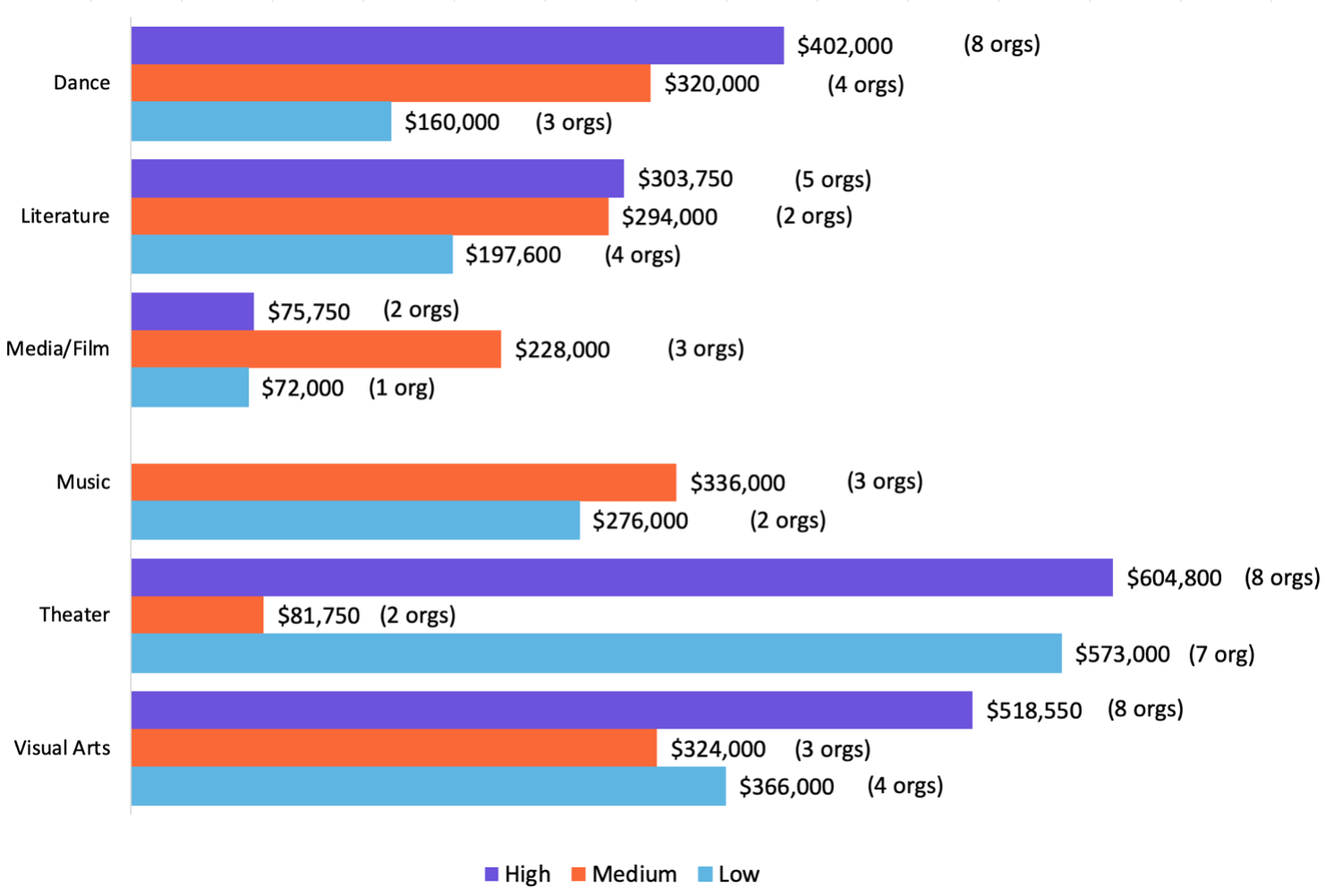
FOR:
Percentage of the grant’s beneficiaries, demonstrated commitment to POC beneficiaries over time, and program/project intentions reflective of the organization’s mission and vision
- High = Beneficiaries are predominately (e.g., three quarters or more) POC
- Medium = A substantive proportion of beneficiaries (e.g., about one-third to below three quarters) are POC
- Low = A low proportion of beneficiaries (e.g., fewer than one-third) are POC
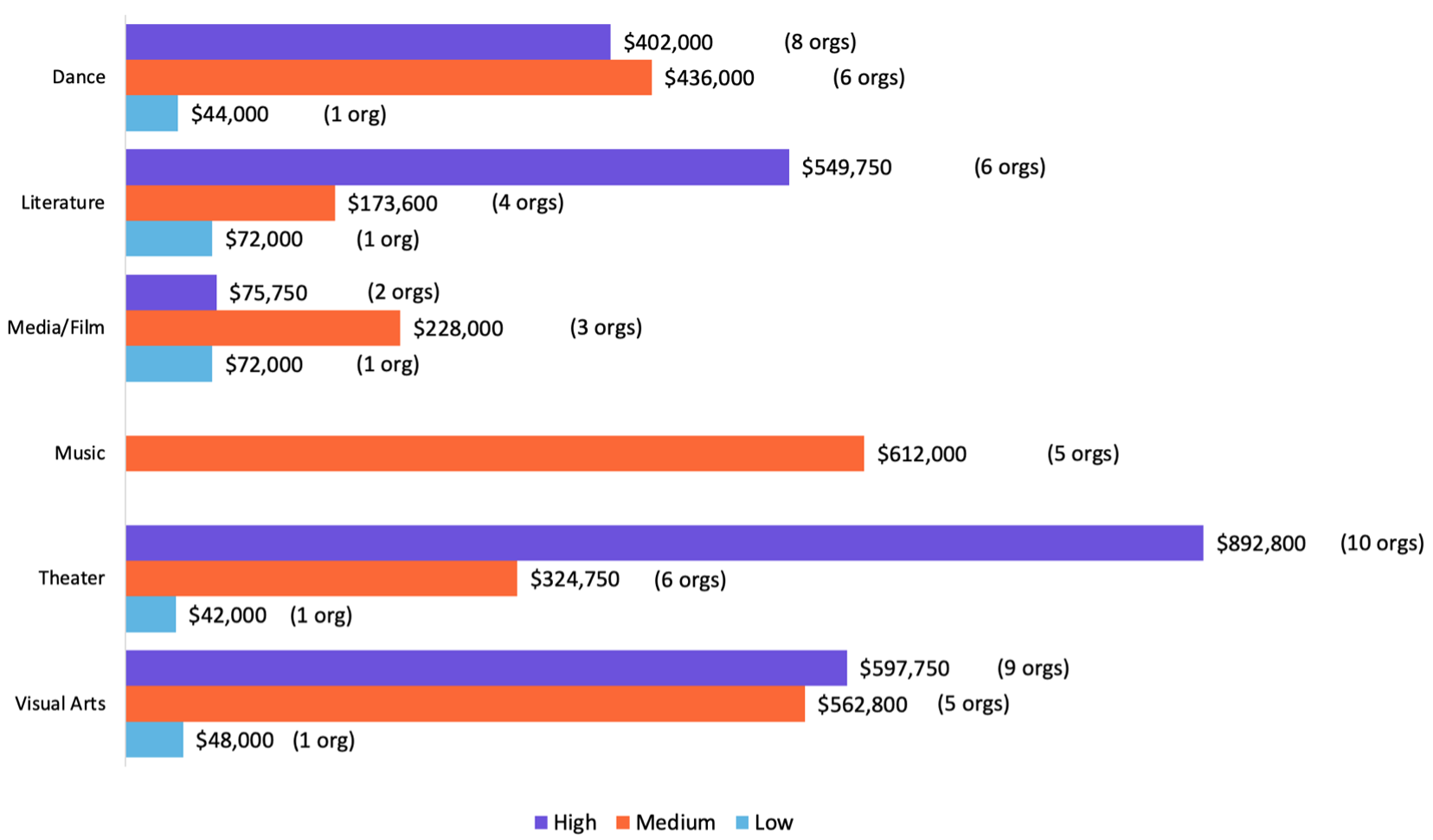
ABOUT:
Percentage of POC program/project leadership and POC program content (including racial equity intentions in the structure of the program activities and goals or purpose)
- High = Project structure and intent describes strategies, barriers to progress, and proposed solutions to racial equity with specificity and nuance. Project leadership are POC Project builds on previous similar programs centering POC.
- Medium = Some evidence of POC-related intent, but limited specificity, solutions, or past programming. Senior project leadership is all or partially POC.
- Low = Little or unclear racial equity intent or POC leadership.
